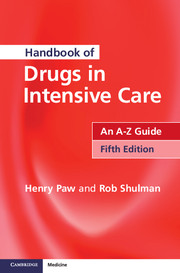Book contents
- Frontmatter
- Contents
- Introduction
- How to use this book
- Abbreviations
- Acknowledgements
- DRUGS: AN A–Z GUIDE
- SHORT NOTES
- APPENDICES
- Appendix A: Creatinine clearance
- Appendix B: Weight conversion (stones/lb to kg)
- Appendix C: Body mass index (BMI) calculator
- Appendix D: Lean body weight charts
- Appendix E: Infusion rate/dose calculation
- Appendix F: Drug compatibility chart
- Appendix G: Omeprazole administration record
- Appendix H: Sodium content of oral medications
- Appendix I: Drug management of the brain-stem-dead donor
- Appendix J: Vancomycin by continuous infusion
- Appendix K: Child-Pugh score
- Appendix L: Severe sepsis algorithm
- DRUG INDEX
- IV COMPATIBILITY CHART
Appendix I: Drug management of the brain-stem-dead donor
Published online by Cambridge University Press: 05 November 2014
- Frontmatter
- Contents
- Introduction
- How to use this book
- Abbreviations
- Acknowledgements
- DRUGS: AN A–Z GUIDE
- SHORT NOTES
- APPENDICES
- Appendix A: Creatinine clearance
- Appendix B: Weight conversion (stones/lb to kg)
- Appendix C: Body mass index (BMI) calculator
- Appendix D: Lean body weight charts
- Appendix E: Infusion rate/dose calculation
- Appendix F: Drug compatibility chart
- Appendix G: Omeprazole administration record
- Appendix H: Sodium content of oral medications
- Appendix I: Drug management of the brain-stem-dead donor
- Appendix J: Vancomycin by continuous infusion
- Appendix K: Child-Pugh score
- Appendix L: Severe sepsis algorithm
- DRUG INDEX
- IV COMPATIBILITY CHART
Summary
• Initially, methylprednisolone 15 mg/kg IV bolus, as soon as possible. Methylprednisolone is associated with reduced lung water and renders the lungs more suitable for transplant
• Continue antibiotics as indicated
• Insulin ≥1 unit/hour, blood glucose target 4–9 mmol/l
• Inotropes and vasopressors may be indicated (p. 277). If response to catecholamine infusion is inadequate, a trial of hydrocortisone 50–100 mg intravenously may improve cardiovascular parameters
• Diabetes insipidus is a common problem and may need treatment with vasopressin (p. 234) or desmopressin (DDAVP) (p. 70)
• Recent studies suggest that tri-iodothyronine (T3) supplementation may add little to an intensive donor management protocol which includes vasopressin and methylprednisolone, and suggest using it only if cardiac performance is unresponsive to volume loading and vasopressors. Tri-iodothyronine (T3) 4 μg IV bolus, followed by IV infusion of 3 μg/h
• If hypernatraemia is a problem, use Ringer's lactate solution (Hartmann's) or a glucose-containing solution. Glucose solution and methylprednisolone may lead to hyperglycaemia, requiring an increase in insulin infusion
• Electrolyte disturbance with low potassium, magnesium, calcium or phosphate should be corrected
• Bradycardia will be unresponsive to atropine, use isoprenaline or dobutamine infusion
• Maintenance intravenous fluids should be limited if ongoing losses are not excessive; enteral route can be considered
- Type
- Chapter
- Information
- Handbook of Drugs in Intensive CareAn A-Z Guide, pp. 334Publisher: Cambridge University PressPrint publication year: 2014



